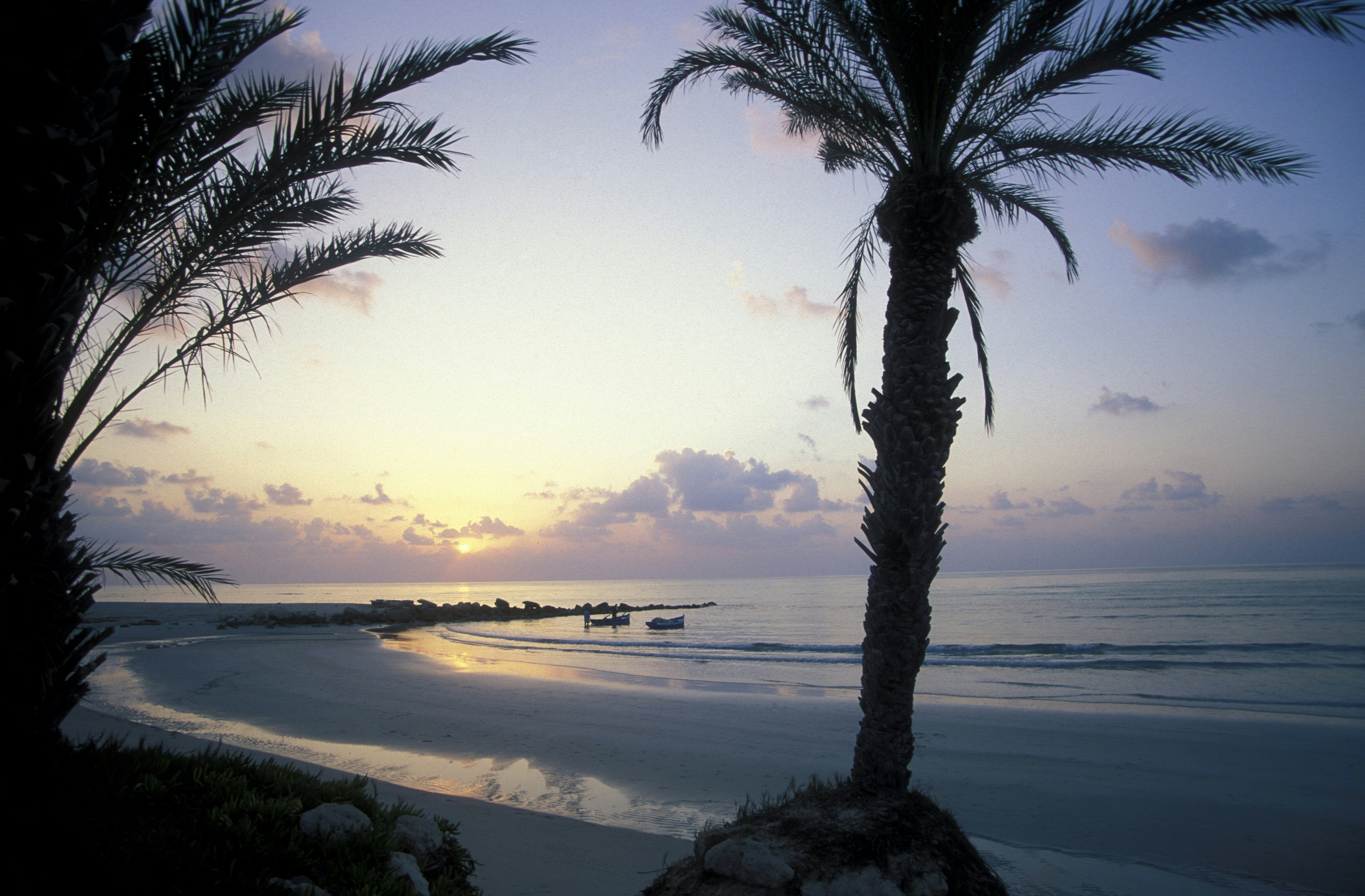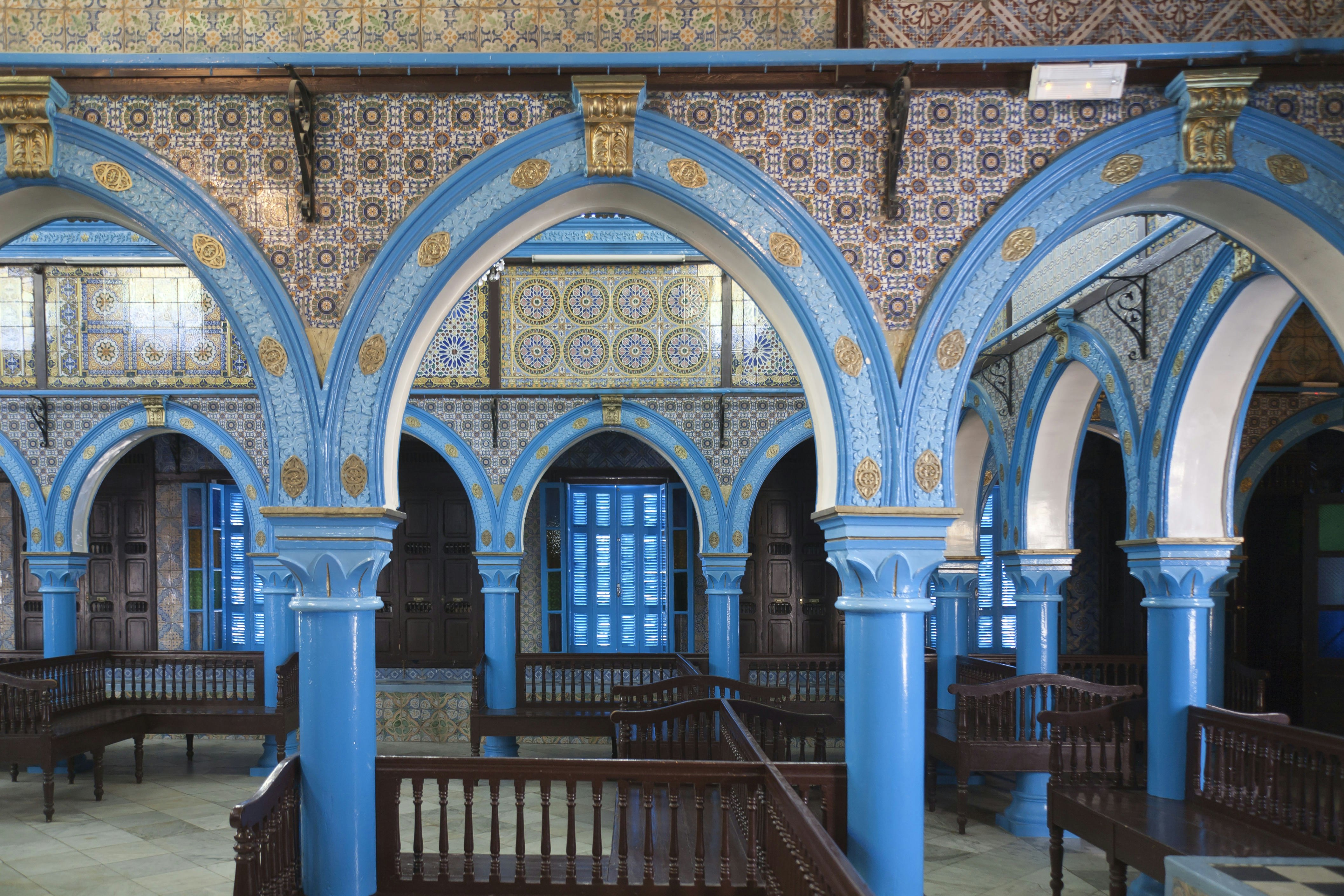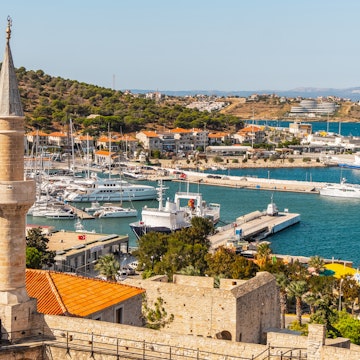

Tunisia, Djerba Island, Houmt Souk, Medenine Governorate, Fort Borj El Kebir. fotostock RM / Getty Images.
For such a small island, Djerba is bursting with cultural richness. Swimming in the sea off Tunisia’s southeastern coast, it contains all the Mediterranean’s usual trimmings but mixes in intoxicating North African roots. Its wonderfully interwoven tapestry is most evident in its people, with the Muslim, Berber and Jewish communities peacefully coexisting on the island as they have done for centuries. The island is home to Africa’s oldest synagogue, whose floors are lined with mats handwoven by local Muslim craftsmen.

Djerba is the sort of place that can entrance you for many days, but if pressed, you could squeeze its highlights into just 24 hours. Dedicate your morning to markets and Mediterranean breezes, your afternoon to understanding its unique Jewish community and admiring the street art tucked away in the enclave’s twisted alleys, and the evening to the sweet sounds of arabesque and a fragrant meal of Djerban rice. In Homer’s Odyssey, this island was known as the Land of the Lotus Eaters, and it’s still easy to understand how it can lull you into blissfully forgetting to return home.
Morning
Start your day in Houmt Souk, the main market town on the island. The streets are lined with white-washed buildings with bright blue shutters, and the walls are dripping with bougainvillea. Morning in Houmt Souk is calm as vendors open up shop and people slowly sip espresso. You’ll see a diverse collection of people out and about, a mix of tourists with bare shoulders and flip-flops, Arab merchants chanting guesses about your country of origin and locals wearing wide-brimmed straw hats and lugging bags of produce to prepare lunch at home.
Wander through the cobblestone streets past the shops selling trinkets and into the twisting medina, where you can find leather goods, colourful textiles and a variety of local ceramics. Make sure to find the alley of local mat and basket weavers, whose handmade palm-frond creations are well-known throughout Tunisia. Though most of the merchants in the market are Muslim, there is a section of that is dominated by Jewish jewellers and silversmiths, and if you can find your way to this knot of streets, you can purchase silver goods, ornate jewellery and antique Judaica from the many shops owned by Jewish Djerban families.
Midday
Once you’ve done your shopping, make your way to the main draw of Djerba: its splendid stretch of beach. Many of the large hotels on the island perch on the water’s edge, but the coastline is open to all, though you might have to pay to use a beach chair. The Mediterranean unfurls in a cerulean ripple from soft white sand, and fuchsia-draped camels, which stroll the beach waiting to give tourists rides, add a distinctly Tunisian touch. Soak in the sunshine and relax, or if you’re feeling adventurous, you can learn how to kitesail or parasail off the coast in the warm Djerban wind. If you have the luxury of an extra day, catch a boat to Flamingo Island, where the water is dotted with the elegant pink birds.
If you’re hungry, stop at a beachside restaurant to try fresh-caught seafood or brik, a flaky fried pastry stuffed with tuna and a runny egg. The patio at Hotel Dar El Bhar serves Tunisian cuisine and wine with lunch, and its water-facing tables let you watch the Arabian horses that take visitors from one side of the shore to the other.

Afternoon
Djerba’s markets, beaches and towns are downright lovely, but nothing speaks to the island’s multicultural heritage like El Ghriba Synagogue. The structure is the cornerstone of the small Jewish population here, who trace their arrival in Tunisia back to the 6th century BC. The whitewashed religious complex contains an open courtyard and the ornate blue-tiled main synagogue, with grand arches and chandeliers hanging from the ceilings. Every spring, Tunisian Jews return from Israel and France for an annual pilgrimage to El Ghriba to celebrate the holiday Lag B’Omer. Security is constant at El Ghriba, so make sure you bring ID to enter.
As you leave the synagogue, stroll the winding roads of the surrounding village of Erriadh. The quiet streets are adorned with vibrant paintings, left over from a 2014 international street art collaboration called Djerbahood, in which 150 artists from 30 countries contributed murals. Most of them are still visible, so keep your eyes peeled for the artwork, as many corners and narrow alleys hold bright murals, cheeky characters and colourful scenes.
Evening
Make your way to the other small Jewish enclave of Hara Kebira, where there is another beautiful old synagogue, to try Tunisian Jewish cuisine. There are a variety of eating options in the neighbourhood, and all are kosher, so there’s no pork, shellfish or mixing of milk and meat. Don't miss the banatage, steaming potato-based dumplings, and the fragrant riz Djerbien, or Djerban rice. If you visit on a Friday, you’ll see Jewish families collect bread at the local community bakery in preparation for Shabbat the next day.
Though much of the evening entertainment in Djerba for visitors revolves around touristy bars in the large hotels that line the beach, there are plenty of opportunities to join the locals. Head coastward to the town of Midoun and stop by El Majless, a tearoom where you can smoke Tunisian shisha late into the night, or visit Restaurant Fatroucha to catch live music, including performances by Arab singers and oud players, for a spirited end to your day.
https://shop.lonelyplanet.com/products/africa-travel-guide-14









